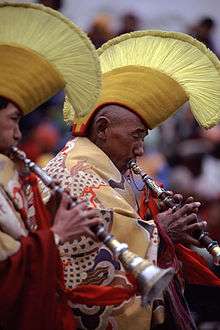Gyaling
The gyaling (Tibetan: རྒྱ་གླི་, Wylie: rgya gli, English: also spelled gya ling, gya-ling, jahlin, jah-lin, jahling, jah-ling, Rgya-gling etc.) Gyaling, literally meaning "Indian trumpet," is a traditional woodwind instrument used in Tibet. Specifically, it is a double reed horn much like the sorna used mainly in Tibetan monasteries during puja (chanting and prayer) and is associated with peaceful deities and the idea of devotion.[1]
 Monks playing gyalings at Spituk monastery, near Leh, Ladakh, India | |
| Classification | Double reed |
|---|---|
| Related instruments | |
Design
The gyaling is oboe-like in appearance with a long hardwood body and copper brass bell. The instrument is generally covered with ornate embellishments of colored glass. The double reed, which is made from a single stem of marsh grass, is placed upon a small metal channel that protrudes out of the top.[2] There are eight (8) fingerholes on a standard gyaling.[3]
To play a gyaling requires a technique called circular breathing, in which the instrument will constantly be emitting a linear sound, even while the musician inhales. The reed is fully submerged in the player’s mouth but does not touch it; the lips are pressed against the flat metal channel below the reed. A gyaling player tunes the instrument with the breath. The way of playing a gyaling varies depending on the lineage and ritual.[4]
Usage in Ritual
A typical Tibetan Buddhist ritual orchestra consists of a gyaling, dungchen, kangling, dungkar (conch shells), drillbu (handbells), silnyen (vertical cymbals), and most importantly, chanting. Together, the music creates a state of mind to invite or summon deities.
Often, the style of performance is similar to that of a bagpipe, with many short and fast neighbor tones.
See also
References
- Kunga Sonam Dronma. "The Vajrakilaya Puja of the Khon Lineage". www.hhthesakyatrizin.org. Archived from the original on 18 January 2011. Retrieved 27 September 2011.
- "Shawms (Rgya Gling) on Exhibit at the National Music Museum". orgs.usd.edu. 9 October 2010. Archived from the original on 15 September 2011. Retrieved 27 September 2011.
- "EBSCOhost Discovery Service: Rgya-gling 1". 0-ehis.ebscohost.com.ignacio.usfca.edu. Retrieved 27 September 2011.
- "Dakini Music - gyaling". www.chagdud.org. Archived from the original on 5 August 2007. Retrieved 27 September 2011.